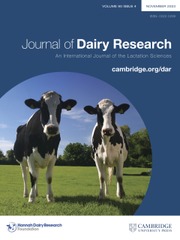No CrossRef data available.
Article contents
Use of a pitanga bagasse (Eugenia uniflora L.) as a new ingredient to improve Petit Suisse's techno-functional properties
Published online by Cambridge University Press: 03 November 2025
Abstract
This research paper evaluated the effects of different concentrations of pitanga (Eugenia uniflora L.) bagasse (PB) on the chemical, technological, and sensory properties of Petit Suisse. Petit Suisse cheeses were formulated without PB (control) and with the enrichment of 0.5%, 1.0%, and 1.5% PB, respectively. The cheeses were evaluated over a 21-day storage period. PB significantly increased Petit Suisse cheeses’ fibre content and yield. There was also an increase in antioxidant activity. Higher levels of PB resulted in lower hardness and greater syneresis. In rheological measurements, the cheeses showed typical behaviour of a viscoelastic solid; However, the inclusion of PB altered the casein network, making the structure softer than the control. The PB does not affect the viability of Lactococcus and Streptococcus, maintaining the probiotic character of the product. The Petit Suisse with 1% PB resulted in greater sensory acceptance. In conclusion, adding pitanga bagasse to Petit Suisse cheese has been demonstrated to provide attractive, functional characteristics and sensory properties, opening new possibilities for product development in the dairy industry.
Information
- Type
- Research Article
- Information
- Copyright
- © The Author(s), 2025. Published by Cambridge University Press on behalf of Hannah Dairy Research Foundation.

